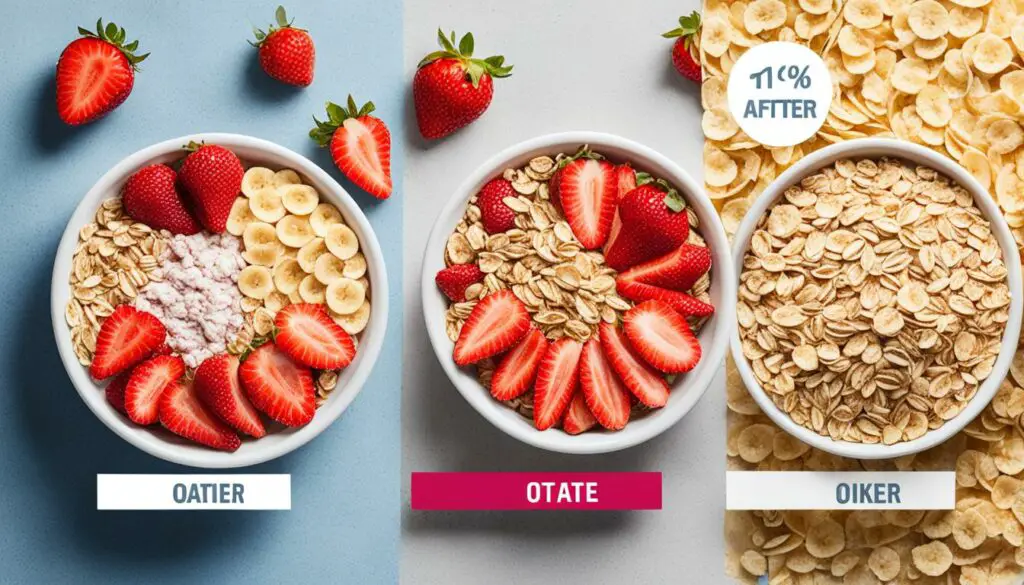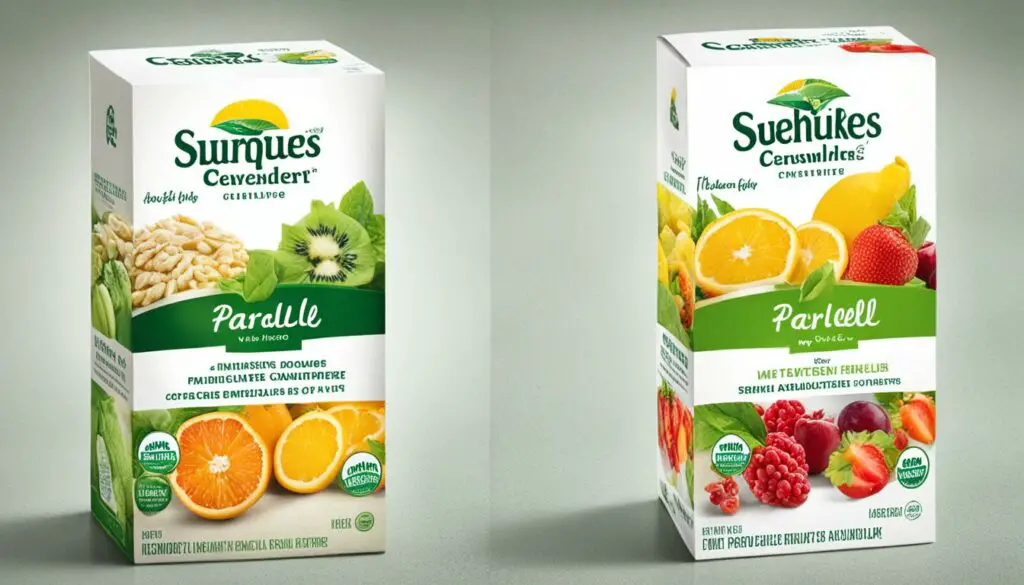Originally posted on February 10, 2024 @ 4:46 am
Quaker, a renowned brand in the oatmeal industry, recently made a significant change to their popular Strawberries & Cream Oatmeal recipe in the United States. This modification has sparked curiosity among consumers who have been enjoying this delightful breakfast option for years. So, did Quaker oatmeal really change their strawberry recipe? Let’s find out.
Contents
- 1 The Impact of Artificial Colors in Food
- 2 Quaker’s Changes to Other Instant Oatmeal Varieties
- 3 Other Food Companies That Made Ingredient Changes
- 4 The Discrepancy Between American and European Food Products
- 5 Examples of Different Products in Europe and America
- 6 The Motivations Behind Different Ingredient Choices
- 7 The Influence of Consumer Advocacy
- 8 The Importance of Removing Artificial Colors
- 9 The Need for Stricter Regulation and Transparency
- 10 The Impact of Consumer Knowledge
- 11 Conclusion
- 12 FAQ
- 12.1 Did Quaker change their Strawberry Oatmeal recipe?
- 12.2 What is the impact of artificial colors in food?
- 12.3 What changes did Quaker make to their other instant oatmeal varieties?
- 12.4 Which other food companies have made ingredient changes?
- 12.5 What are the discrepancies between American and European food products?
- 12.6 Can you provide examples of different products in Europe and America?
- 12.7 What motivates companies to make different ingredient choices?
- 12.8 How does consumer advocacy influence the food industry?
- 12.9 Why is it important to remove artificial colors from food products?
- 12.10 What is the need for stricter regulation and transparency in the food industry?
- 12.11 How does consumer knowledge impact food choices?
- 13 Source Links
Key Takeaways:
- Quaker oatmeal has undergone a recipe transformation, addressing consumer demands for healthier and more natural ingredients.
- The American version of Quaker’s Strawberries & Cream Oatmeal previously used artificial flavors and colors for strawberry flavor.
- Due to consumer advocacy, Quaker has made the strategic decision to switch to using real strawberries in their American oatmeal recipe.
- This change eliminates artificial colors, which have been linked to health concerns such as hyperactivity in children.
- Consumer awareness and demand have the power to influence food companies to make positive ingredient changes, prioritizing the well-being of their customers.
The Impact of Artificial Colors in Food

Artificial colors, often used for aesthetic purposes, can have negative impacts on our health. They have been found to disrupt the immune system, as the immune system struggles to defend the body against these synthetic colorants. Additionally, artificial colors are man-made in a lab using chemicals derived from petroleum, and they have been found to be contaminated with known carcinogens. Countries like Norway and Austria have banned these colors, and they are required to bear warning labels in other countries.
Artificial colors have also been associated with increased hyperactivity in children and have been linked to long-term health problems such as asthma, skin rashes, and migraines. Removing artificial colors from food products is a positive step towards safer and healthier options for consumers.
The Dangers of Artificial Colors
Artificial colors used in food have significant implications for our health. For instance, these colors have been found to disrupt the functioning of the immune system, leading to potential allergies and sensitivities. When the immune system identifies these synthetic colorants as foreign substances, it activates an immune response, resulting in inflammation and other adverse reactions.
Moreover, artificial colors are derived from petroleum-based chemicals, which can contain known carcinogens and contaminants. These harmful substances pose serious health risks, including an increased risk of cancer, when consumed over time.
Artificial colors have also shown a strong correlation with hyperactivity in children. Numerous studies have linked the consumption of these colorants to behavioral issues and ADHD-like symptoms in sensitive individuals. Furthermore, long-term exposure to artificial colors has been associated with various health problems, including asthma, skin rashes, and migraines.
“Artificial colors have been found to disrupt the immune system and have been linked to increased hyperactivity in children.”
The use of artificial colors in food products is a cause for concern. Governments and regulatory bodies in some countries, such as Norway and Austria, have taken action by banning these colors or requiring warning labels on products containing them. These measures aim to protect consumers and promote safer food choices.
By eliminating artificial colors from food products, companies can provide consumers with healthier options. The switch to natural and plant-based colorants avoids the potential dangers associated with artificial colors while maintaining the aesthetic appeal and visual appeal of food products.
Consumers can take an active role in promoting the removal of artificial colors by making informed choices and supporting companies that prioritize natural ingredients. By raising awareness about the risks of artificial colors and demanding transparency in labeling, consumers can encourage the food industry to prioritize the health and well-being of their customers.
Quaker’s Changes to Other Instant Oatmeal Varieties

Quaker, known for its commitment to offering healthier options, has made notable changes to their range of instant oatmeal varieties. One example is the removal of artificial colors and caramel color, which has been linked to cancer, from their popular Dinosaur Eggs Instant Oatmeal for kids. These additives were replaced with natural colors derived from radishes, spirulina, and turmeric. This modification serves as a testament to Quaker’s dedication to providing safer and more appealing options for children.
By eliminating artificial colors, Quaker’s instant oatmeal becomes an enticing choice for health-conscious consumers. The removal of these additives not only enhances the nutritional value of the product but also addresses concerns related to the potential health risks associated with artificial colors. Quaker’s decision to prioritize the well-being of their customers by removing artificial colors exemplifies their commitment to delivering quality products.
Supporting and encouraging food companies to make positive changes, like Quaker has done, is crucial in promoting a healthier food industry. When consumers actively choose and support products that prioritize natural ingredients, it sends a clear message to companies that the well-being of their customers matters.
Quaker’s Changes to Dinosaur Eggs Instant Oatmeal
Here is a visual representation of the changes made to Quaker’s Dinosaur Eggs Instant Oatmeal:
| Previous Recipe | Updated Recipe |
|---|---|
| Artificial colors and caramel color | Natural colors made from radishes, spirulina, and turmeric |
Quaker’s dedication to improving the ingredients in their products, such as their Dinosaur Eggs Instant Oatmeal, is a positive step towards a healthier food industry. Encouraging other food companies to follow suit and adopt similar changes will contribute to a market that prioritizes the well-being of consumers.
Other Food Companies That Made Ingredient Changes

McDonald’s, the global fast food chain, has made notable ingredient changes in its products as well. In the United Kingdom, McDonald’s french fries are made without certain additives like dimethylpolysiloxane, which is used in the U.S. These changes align with the company’s commitment to providing healthier options for their customers, free from unnecessary additives and controversial ingredients.
In a world where consumers are increasingly concerned about the quality and safety of the food they consume, these changes made by Kellogg’s and McDonald’s highlight the power of consumer awareness and advocacy. It is evident that companies are willing to make ingredient improvements when faced with informed and empowered customers who demand safer and healthier options.
The Discrepancy Between American and European Food Products
A major issue in the food industry is the discrepancy between American and European food products. Many companies, such as Kraft-Heinz, Kellogg’s, PepsiCo, and Quaker, sell safer and better versions of their products in Europe while providing inferior options with different ingredients in the U.S. This discrepancy is due to the different approaches taken by European and American food regulations.
Europe follows a precautionary principle, which means they ban or add warning labels to potentially risky additives, ensuring a higher level of consumer protection. In contrast, the U.S. allows food companies to decide which ingredients are deemed safe, resulting in Americans being exposed to potentially harmful substances until proven otherwise. This disparity highlights the need for stricter regulations and greater transparency in the American food industry.
The European precautionary principle prioritizes consumer safety and helps to eliminate potentially harmful ingredients from food products. By banning or adding warning labels to these substances, food companies are compelled to find safer alternatives. This approach not only safeguards public health but also encourages innovation and the development of healthier food options.
European Precautionary Principle
The European precautionary principle is a principle of utmost importance in the European Union (EU), aiming to protect consumers from potential risks associated with various products, including food. It applies when scientific evidence is uncertain, but there are indications of potential risks to human health or the environment. Under this principle, regulators take preventive measures by banning or imposing restrictions on products until their safety is adequately demonstrated. By adopting this approach, European countries prioritize the well-being of their citizens and consistently strive to maintain high food safety standards.
| European | American |
|---|---|
| Bans or restricts potentially risky additives | Relies on companies to decide ingredient safety |
| Puts consumer safety first | Places burden of proof on consumers |
| Encourages the development of healthier options | Prioritizes profit margins over consumer health |
The table above summarizes the significant contrasts between European and American food regulations. European regulations, driven by the precautionary principle, emphasize consumer safety, compelling companies to prioritize product quality and health. In contrast, American regulations rely on companies to make their own safety determinations, leading to potential risks for consumers.
In Europe, food companies prioritize consumer safety by choosing to sell healthier alternatives with safer ingredients. However, in the U.S., where regulations are more lenient, companies often prioritize profit over the health and well-being of consumers.
This discrepancy in regulatory standards necessitates the implementation of stricter regulations and greater transparency in the American food industry. By adopting a precautionary approach and prioritizing consumer safety, the U.S. can ensure that its citizens have access to the same level of food safety as their European counterparts.
Examples of Different Products in Europe and America
The differences between European and American food products are evident across various categories. These disparities in ingredients can significantly impact the quality, taste, and nutritional value of food. Let’s explore some examples of how food products differ between Europe and America:
McDonald’s Fries: A Simple Ingredient Contrast
In the United Kingdom, McDonald’s serves fries made with simple ingredients like potatoes, oil, dextrose, and salt. However, the American version includes additives like “natural beef flavor” and sodium acid pyrophosphate, which may alter the taste and overall composition of the fries.
Quaker’s Strawberries & Cream Oatmeal: Real Fruit vs. Artificial Flavors
The U.S. version of Quaker’s Strawberries & Cream Oatmeal used to lack real strawberries, unlike the U.K. version that contained actual fruit. This difference in ingredient choice could significantly impact the flavor and nutritional value of the product.
Mountain Dew: Natural Color vs. Artificial Dye
In the United Kingdom, Mountain Dew gets its bright yellow color from beta carotene, a natural pigment found in fruits and vegetables. However, the American version is artificially colored with Yellow #5, a petroleum-based dye. This disparity highlights the contrast between natural and artificial coloring agents.
Heinz Tomato Ketchup: GMO-Free vs. GMO-Containing
Heinz Tomato Ketchup is GMO-free in the United Kingdom, aligning with the demand for cleaner and more natural ingredients. However, the American version contains GMOs and high fructose corn syrup, which may be a concern for health-conscious consumers.
These examples illustrate just a few of the ingredient differences between American and European food products. It’s essential for consumers to be aware of these disparities and make informed choices that align with their preferences and values.
The Motivations Behind Different Ingredient Choices
The main motivation for the use of different ingredients in American food products is cost reduction. Companies know they can get away with using cheaper flavor enhancers, color additives, preservatives, and GMO ingredients in the U.S. market.
Cheaper alternatives may have negative impacts on health, but as long as they meet the minimal legal requirements, companies will continue to prioritize their profit margins over the well-being of consumers.
This highlights the need for increased consumer awareness and demand for healthier options to incentivize companies to make better ingredient choices.
The Influence of Consumer Advocacy
The changes made by Quaker and other food companies can be attributed to consumer advocacy. Increased awareness and sharing of information about the differences in food products have put pressure on these companies to improve their offerings. The power of the consumer’s voice, coupled with voting with their dollars, has shown that companies are listening and willing to make changes. Petitions, like the one that led to the removal of BHT from Kellogg’s cereals, demonstrate the efficacy of collective action in influencing food companies. By sharing the truth about food products and supporting companies that prioritize safe and healthy ingredients, consumers can continue to drive positive change in the food industry.
Consumer Advocacy: Influencing the Food Industry
“The changes made by food companies reflect the growing impact of consumer advocacy in the food industry. As consumers become more aware of the potential health risks associated with certain ingredients, they are demanding safer and healthier options. This has forced companies to listen and make meaningful changes to their recipes and formulations.”
The influence of consumer advocacy in the food industry cannot be understated. In today’s age of information sharing and social media, consumers have a powerful platform to voice their concerns and demands. By raising awareness about the differences in food products, consumers are holding companies accountable for the ingredients they use and the impact on consumer health. Through petitions, social media campaigns, and consumer activism, individuals and groups have successfully influenced food companies to make significant ingredient changes.
One example of the impact of consumer advocacy is the removal of BHT, a controversial preservative, from Kellogg’s cereals. Consumers voiced their concerns about the potential health risks associated with this additive, leading to a successful petition and subsequent removal of BHT from the company’s products. This demonstrates the power of collective action in influencing food companies to prioritize safer ingredients.
Sharing information about food products and their ingredients is a vital aspect of consumer advocacy. With access to a wealth of information online, consumers are more informed than ever before. They can research and educate themselves about the potential health risks associated with certain additives and ingredients. By spreading this knowledge to others, consumers can collectively push for healthier options and drive the food industry towards safer practices.
In addition to sharing information, consumers can make their voices heard through their purchasing decisions. Supporting companies that prioritize safe and healthy ingredients sends a clear message to the food industry. When consumers choose products from companies that have made ingredient changes in response to consumer demand, it reinforces the notion that companies must prioritize the well-being of their customers.
Consumer advocacy has the power to create meaningful change in the food industry. As consumers continue to demand transparency, safer ingredients, and healthier options, they are influencing companies to reconsider their formulations and take consumer health into account. Through collective action, sharing information, and voting with their dollars, consumers can continue to drive positive change and shape the future of the food industry.
| Advantages of Consumer Advocacy | Methods of Consumer Advocacy |
|---|---|
| 1. Influence ingredient changes in food products. | 1. Petitions and online campaigns. |
| 2. Hold companies accountable for the ingredients they use. | 2. Sharing information through social media. |
| 3. Demand transparency in food labeling. | 3. Educating others about potential health risks. |
| 4. Promote healthier options in the market. | 4. Supporting companies with safe and healthy ingredients. |
| 5. Drive positive change in the food industry. | 5. Exercising purchasing power to support responsible companies. |
The Importance of Removing Artificial Colors
Removing artificial colors from food products is essential for promoting better health. Artificial colors have been linked to a range of negative effects on our well-being. These colors are typically man-made in a lab using chemicals derived from petroleum. They often contain known carcinogens and can disrupt the immune system.
One of the most concerning issues associated with artificial colors is their impact on children’s behavior. Studies have shown a connection between artificial colors and increased hyperactivity in children. These colors have also been linked to long-term health problems, including asthma, skin rashes, and migraines.
By eliminating artificial colors from food products, companies can provide healthier options for consumers and address concerns related to the negative effects of these additives. Choosing natural colors derived from fruits, vegetables, and other natural sources offers the same visual appeal while minimizing potential health risks.
Consumers play a crucial role in driving this important change. By supporting and advocating for products that prioritize the use of natural colors, we can encourage food companies to prioritize safer and healthier ingredients. Together, we can create a food industry that prioritizes the well-being of consumers.
| Health Benefits of Removing Artificial Colors | Artificial Colors | Natural Colors |
|---|---|---|
| Minimizes potential health risks | Linked to immune system disruption and carcinogens | Derived from fruits, vegetables, and natural sources |
| Reduces hyperactivity in children | Associated with increased hyperactivity | Free from artificial additives |
| Prevents long-term health problems | Linked to asthma, skin rashes, and migraines | Offers natural and safe alternatives |
The Need for Stricter Regulation and Transparency
The discrepancies between American and European food products highlight the dire need for stricter regulations and greater transparency in the food industry. While Europe prioritizes consumer safety through the precautionary principle, the American system allows companies to self-regulate and determine the safety of their own ingredients. This lack of oversight puts consumers at risk and perpetuates the use of potentially harmful additives.
Stricter regulations would ensure that food companies are held accountable for the ingredients they use and the claims they make, providing consumers with more accurate information about the products they consume. Transparency is crucial in enabling consumers to make informed decisions and protect their health.
“Consumers have the right to know what they are putting into their bodies and to have confidence in the safety and quality of the food they consume.”
Increased transparency would also encourage food companies to adopt healthier practices and phase out controversial additives. By revealing their sourcing, production methods, and ingredient lists, companies can build trust with consumers and prioritize their well-being over profit margins.
The Precautionary Principle: Europe’s Approach to Consumer Safety
The precautionary principle is a fundamental aspect of Europe’s food regulations. It places the burden of proof on companies to demonstrate the safety of their products before they can be introduced to the market. In practice, this means that potentially harmful substances or additives are banned or required to bear warning labels until proven safe.
This approach ensures that European consumers have access to safer and better-quality products. It also emphasizes the importance of extensive testing, thorough risk assessments, and scientific consensus before an ingredient or additive is approved for use.
The American System: Self-Regulation and Industry Influence
In contrast to Europe, the American system relies heavily on self-regulation, allowing food companies to determine the safety of their own ingredients and make their own claims. While the U.S. Food and Drug Administration (FDA) requires companies to provide evidence of safety, the burden of proof is often less stringent than in Europe, resulting in a higher tolerance for potentially harmful additives.
This self-regulation allows companies to prioritize their own interests, including cost reduction and profit maximization, over the health and well-being of consumers. It also gives the industry substantial influence over the regulatory process, further compromising transparency and consumer safety.
It is clear that the American food industry would greatly benefit from stronger regulations that prioritize consumer safety and promote transparency.
The Role of Consumer Advocacy
Consumer advocacy plays a crucial role in driving change and influencing the food industry to prioritize safer ingredients and better practices. When consumers demand transparency, ask questions about sourcing and production methods, and refuse to support companies that compromise their health, it puts pressure on the industry to make improvements.
“By staying informed, asking questions, and making conscious choices, consumers have the power to shape the food industry and drive positive change.”
Consumer advocacy has already shown its effectiveness in prompting food companies to reformulate their products. This has resulted in the removal of artificial colors, the elimination of controversial additives, and the use of healthier ingredients. By supporting companies that prioritize transparency and consumer safety, consumers can encourage the entire food industry to adopt higher standards.
Stricter Regulation and Transparency: A Path to a Healthier Future
Implementing stricter regulations and promoting transparency in the food industry is essential to protect consumers’ health and well-being. By aligning with the precautionary principle and adopting European-style regulations, the American food industry can ensure the availability of safer and better-quality products.
| Aspect | Europe | America |
|---|---|---|
| Regulatory Approach | Precautionary Principle – prioritize consumer safety | Self-regulation with minimal oversight |
| Ingredient Approval | Rigorous testing and risk assessments required for approval | Companies determine the safety of their own ingredients |
| Controversial Additive Usage | Banned or labeled until proven safe | Tolerated unless proven harmful |
| Transparency | Emphasized, giving consumers accurate information | Varies among companies, often lacking full disclosure |
| Consumer Advocacy | Reforms driven by consumer demand and awareness | Consumers play a critical role in demanding change |
The Impact of Consumer Knowledge
Consumer knowledge and awareness have a profound influence on the choices individuals make when it comes to their food purchases. By staying informed about the differences between food products in the U.S. and Europe, consumers can make more educated decisions about the foods they consume. This knowledge allows them to understand the potential health risks associated with additives like artificial colors and make conscious choices that align with their values and health priorities.
Empowered with this information, consumers have the power to shape the market and drive positive change in the food industry. By actively supporting companies that prioritize safe and healthier ingredients, consumers send a clear message that they value transparency, quality, and their own well-being. Through their collective actions, they can influence the industry to adopt more transparent practices and offer products that align with their expectations.
“Consumer knowledge empowers individuals to make informed decisions, supporting companies that prioritize their health and well-being.”
Additionally, consumer knowledge plays a crucial role in demanding transparency from food companies. When consumers are aware of the potential risks associated with certain additives or ingredients, they can advocate for clearer labeling and disclosure. By demanding greater transparency, consumers ensure that they have access to accurate information about the quality and safety of the food products they purchase.
Moreover, being informed about the differences in food products allows consumers to identify companies that prioritize their values and health. By actively supporting such companies, consumers encourage others to follow suit, creating a ripple effect that pushes the industry to embrace safer and healthier ingredient choices. Informed consumers have the ability to drive positive change, encouraging the food industry to prioritize the well-being of their customers.
The Power of Informed Consumer Decision-Making
The impact of consumer knowledge on the food industry cannot be underestimated. Informed consumer decision-making drives the demand for healthier, safer, and more transparent food options. By staying informed, making conscious choices, and actively supporting companies that align with their values, consumers have the power to create a market that prioritizes their well-being and the well-being of future generations.
| Benefits of Informed Consumer Decision-Making | Examples |
|---|---|
| Healthier Choices: Consumers can select food products that are free from artificial colors, additives, and potentially harmful ingredients. | Choosing organic produce, products with clean ingredient lists, or supporting companies that prioritize natural ingredients. |
| Transparency: Consumers can demand clearer labeling and information about the composition and sourcing of food products. | Supporting companies that provide detailed ingredient lists and share information about their production practices. |
| Positive Market Impact: Consumer demand for healthier options encourages companies to reformulate their products and prioritize the well-being of their customers. | Companies like Quaker and Kellogg’s making ingredient changes in response to consumer advocacy. |
In conclusion, consumer knowledge is a powerful tool that can reshape the food industry. Informed consumers drive demand for safer, healthier, and more transparent food options. By staying aware of the differences between food products, making conscious choices, and actively supporting companies that prioritize their well-being, consumers have the ability to influence positive change in the industry. It is the collective power of informed consumer decision-making that will ultimately shape the future of our food system.
Conclusion
The recent ingredient changes made by Quaker to their strawberry oatmeal recipe serve as a testament to the power of consumer advocacy within the food industry. By voicing their concerns and demanding safer and healthier ingredients, consumers have successfully influenced food companies like Quaker to reformulate their products. Quaker’s decision to switch to using real strawberries and eliminate artificial colors is a significant step towards providing consumers with better options.
This change not only showcases how consumer awareness can drive positive change but also highlights the willingness of companies to prioritize the health and well-being of their customers. It is essential for consumers to stay informed and continue sharing information about food products, supporting companies that make positive ingredient changes, and advocating for stricter regulations in the food industry.
With continued consumer advocacy, we can encourage more food companies to improve their recipes, be transparent about their ingredients, and prioritize the health of their consumers. By working together, we can create a food industry that offers safe and healthy options for everyone.
FAQ
Did Quaker change their Strawberry Oatmeal recipe?
Yes, Quaker recently made a significant change to their Strawberries & Cream Oatmeal recipe in the U.S., switching to using real strawberries instead of artificial flavoring and colorants.
What is the impact of artificial colors in food?
Artificial colors in food can have negative effects on health, including disrupting the immune system, introducing synthetic chemicals derived from petroleum, and potentially containing known carcinogens.
What changes did Quaker make to their other instant oatmeal varieties?
Quaker removed artificial colors and caramel color, replacing them with natural colors made from ingredients like radishes, spirulina, and turmeric in their Dinosaur Eggs Instant Oatmeal for kids.
Which other food companies have made ingredient changes?
Kellogg’s removed the preservative BHT from their Frosted Flakes cereal, and McDonald’s has made ingredient adjustments, such as eliminating certain additives, in their fries in the U.K.
What are the discrepancies between American and European food products?
European food products often have safer and better-quality ingredients compared to their American counterparts due to stricter regulations and the precautionary principle followed in Europe.
Can you provide examples of different products in Europe and America?
Some examples include McDonald’s fries, Quaker’s Strawberries & Cream Oatmeal, Mountain Dew, and Heinz Tomato Ketchup, which all have differences in ingredients between the two regions.
What motivates companies to make different ingredient choices?
Companies often prioritize cost reduction, using cheaper alternatives that may have potential negative health impacts to maximize their profits.
How does consumer advocacy influence the food industry?
Consumer advocacy raises awareness and puts pressure on food companies to prioritize safer and healthier ingredients. Companies may reformulate their products in response to informed and empowered consumers.
Why is it important to remove artificial colors from food products?
Artificial colors have been linked to health concerns such as hyperactivity in children and long-term health problems like asthma and migraines. Eliminating artificial colors provides safer options for consumers.
What is the need for stricter regulation and transparency in the food industry?
Stricter regulations and greater transparency would ensure that consumers have accurate information about the ingredients in their food, promoting safer and more accountable practices within the industry.
How does consumer knowledge impact food choices?
Being informed about the differences in food products and their potential health risks empowers consumers to make conscious choices that align with their values and health priorities.








